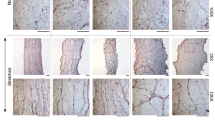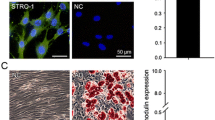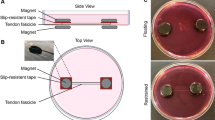Abstract
Tendon cells respond to mechanical loads. The character (anabolic or catabolic) and sensitivity of this response is determined by the mechanostat set point of the cell, which is governed by the cytoskeleton and its interaction with the extracellular matrix. To determine if loss of cytoskeletal tension following stress deprivation decreases the mechanoresponsiveness of tendon cells, we cultured rat tail tendons under stress-deprived conditions for 48 hours and then cyclically loaded them for 24 hours at 1%, 3%, or 6% strain at 0.17 Hz. Stress deprivation upregulated MMP-13 mRNA expression and caused progressive loss of cell-matrix contact compared to fresh controls. The application of 1% strain to fresh tendons for 24 hours inhibited MMP-13 mRNA expression compared to stress-deprived tendons over the same period. However, when tendons were stress-deprived for 48 hours and then subjected to the same loading regime, the inhibition of MMP-13 mRNA expression was decreased. In stress-deprived tendons, it was necessary to increase the strain magnitude to 3% to achieve the same level of MMP-13 mRNA inhibition seen in fresh tendons exercised at 1% strain. The data suggest loss of cytoskeletal tension alters the mechanostat set point and decreases the mechanoresponsiveness of tendon cells.




Similar content being viewed by others
References
Alfredson H, Lorentzon M, Bäckman S, Bäckman A, Lerner UH. cDNA arrays and real time qualitative PCR techniques in the investigation of chronic Achilles tendinosis. J Orthop Res. 2003;21:970–975.
Arnoczky SP, Lavagnino M, Egerbacher M. The response of tendon cells to changing loads: implications in the etiopathogenesis of tendinopathy. In: Woo S-L-Y, Renstrom P, Arnoczky SP, eds. Understanding and Prevention of Tendinopathy in the Athlete, Encyclopedia of Sports Medicine. Blackwell Publishing: Oxford, England; 2007:46–59.
Arnoczky SP, Lavagnino M, Egerbacher M. The mechanobiological aetiopathogenesis of tendinopathy: is it the over-stimulation or the under-stimulation of tendon cells? Int J Exp Path. 2007;88:217–226.
Arnoczky SP, Lavagnino M, Whallon JJ, Hoonjan A. In situ cell nucleus deformation under tensile load: a morphologic analysis using confocal laser microscopy. J Orthop Res. 2002;20:29–35.
Arnoczky SP, Tian T, Lavagnino M, Gardner K. Ex vivo static tensile loading inhibits MMP-1 expression in rat-tail tendon cells through a cytoskeletally based mechanotransduction mechanism. J Orthop Res. 2004;22:328–333.
Banes AJ, Horesovsky G, Larson C, Tsuzaki M, Judex S, Archambault J, Zernicke R, Herzog W, Kelley S, Miller L. Mechanical load stimulates expression of novel genes in vivo and in vitro in avian flexor tendon cells. Osteoarthritis Cartilage. 1999;7:141–153.
Banes AJ, Tsuzaki M, Hu P, Brigman B, Brown T, Almekinders L, Lawrence WT, Fischer T. Cyclic mechanical load and growth factors stimulate DNA synthesis in avian tendon cells. J Biomech. 1995;28:1505–1513.
Banes AJ, Tsuzaki M, Yamamoto J, Fischer T, Brigman B, Brown T, Miller L. Mechanoreception at the cellular level: the detection, interpretation, and diversity of responses to mechanical signals. Biochem Cell Biol. 1995;73:349–365.
Bonaldo P, Russo V, Bucciotti F, Doliana R, Colombatti A. Structural and functional features of the α3 chain indicate a bridging role for chicken collagen VI in connective tissues. Biochemistry. 1990;29:1245–1254.
Brown RA, Prajapati R, McGrouther DA, Yannus IV, Eastwood M. Tensional homeostasis in dermal fibroblasts: mechanical responses to mechanical loading in three dimensional substrates. J Cell Physiol. 1998;175:323–332.
Cannell LJ, Taunton JE, Clement DB, Smith C, Khan KM. A randomized clinical trial of the efficacy of drop squats or leg curl exercises to treat clinically diagnosed jumper’s knee in athletes: pilot study. Br J Sports Med. 2001;35:60–64.
Chen CS, Ingber DE. Tensegrity and mechanoregulation: from skeleton to cytoskeleton. Osteoarthritis Cartilage. 1999;7:81–94.
Chicurel ME, Chen CS, Ingber DE. Cellular control lies in the balance of forces. Curr Opin Cell Biol. 1998;10:232–239.
Ciarelli MJ, Arnoczky SP, Kilfoyle SJ, Makidon PE. Demonstration of intercellular communications (gap junctions) in tendon cells in situ. Trans Orthop Res. 1996;21:372.
Donahue HJ. Gap junctional intercellular communications in bone: a cellular basis for the mechanostat set point. Calcif Tissue Int. 1998;62:85–88.
Eastwood M, McGrouther DA, Brown RA. Fibroblast responses to mechanical forces. Proc Instn Mech Eng [H]. 1998;212:85–92.
Egerbacher M, Arnoczky SP, Caballero O, Lavagnino M, Gardner KL. Loss of homeostatic tension induces apoptosis in tendon cells: an in vitro study. Clin Orthop Relat Res. 2008;466. DOI: 10.1007/s11999-008-0274-8.
Frost HM. Bone “mass” and the “mechanostat”: a proposal. Anat Rec 1987;219:1–9.
Fu SC, Chan BP, Wang W, Pau HM, Chan KM, Rolf CG. Increased expression of matrix metalloproteinase 1 (MMP-1) in 11 patients with patellar tendinosis. Acta Orthop Scand. 2002;73:658–662.
Grinnell F. Signal transduction pathways activated during fibroblast contraction of collagen matrices. Curr Topic Pathol. 1999;93:61–73.
Hannafin JA, Arnoczky SP, Hoonjan A, Torzilli PA. The effect of immobilization and cyclic tensile loading on the histology and material properties of canine flexor digitorum profundus tendons: an in vitro study. J Orthop Res. 1995;13:907–914.
Ingber DE. Integrins as mechanochemical transducers. Curr Opin Cell Biol. 1991;3:841–848.
Ingber DE. Tensegrity: the architectural basis of cellular mechanotransduction. Annu Rev Physiol. 1997;59:575–599.
Ireland D, Harrall R, Curry V, Holloway G, Hackney R, Hazleman B, Riley G. Changes in gene expression in chronic human Achilles tendinopathy. Matrix Biol. 2001;20:159–169.
Janmey PA. The cytoskeleton and cell signaling component localization and mechanical coupling. Physiol Rev. 1998;78:763–781.
Järvinen M, Józsa L, Kannus P, Järvinen TL, Kvist M, Leadbetter W. Histopathological findings in chronic tendon disorders. Scand J Med Sci Sports. 1997;7:86–95.
Jensen K, DiFabio RP. Evaluation of eccentric exercise in treatment of patellar tendonitis. Phys Ther. 1989;69:211–216.
Jones GC, Corps AN, Penninton CJ, Clark IM, Edwards DR, Bradley MM, Hazelman BL, Riley GP. Expression profiling of metalloproteinases and tissue inhibitors of metalloproteinases in normal and degenerative human Achilles tendon. Arthritis Rheum. 2006;54:832–842.
Jonsson P, Alfredson H. Superior results with eccentric compared to concentric quadriceps training in patients with jumper’s knee: a prospective randomized study. Br J Sports Med. 2005;39:847–850.
Józsa LG, Reffy A, Kannus P, Demel S, Elek E. Pathological alterations in human tendons. Arch Orthop Trauma Surg. 1990;110:15–21.
Kannus P, Józsa LG. Histopathological changes preceding spontaneous rupture of a tendon. A controlled study of 891 patients. J Bone Joint Surg Am. 1991;73:1507–1525.
Kongsgaard M, Aagaard P, Roikjaer S, Olsen D, Jensen M, Langberg H, Magnusson SP. Decline eccentric squats increase patellar tendon loading compared to standard eccentric squats. Clin Biomech. 2006;21:748–754.
Lavagnino M, Arnoczky SP. In vitro alterations in cytoskeletal tensional homeostasis control gene expression in tendon cells. J Orthop Res. 2005;23:1211–1218.
Lavagnino M, Arnoczky SP, Egerbacher M, Gardner K, Burns ME. Isolated fibrillar damage in tendons stimulates local collagenase mRNA expression and protein synthesis. J Biomech. 2006;39:2355–2362.
Lavagnino M, Arnoczky SP, Frank K, Tian T. Collagen fiber diameter distribution does not reflect changes in the mechanical properties of stress-deprived tendons. J Biomech. 2005;38:69–75.
Lavagnino M, Arnoczky SP, Tian T, Vaupel Z. Effect of amplitude and frequency of cyclic tensile strain on the inhibition of MMP-1 mRNA expression in tendon cells: in vitro study. Connect Tissue Res. 2003;44:181–187.
Leadbetter WB. Cell-matrix response in tendon injury. Clin Sports Med. 1992;11:533–578.
Lian O, Scott A, Engebretsen L, Bahr R, Duronio V, Khan K. Excessive apoptosis in patellar tendinopathy in athletes. Am J Sports Med. 2007;35:605–611.
Lo IKY, Marchuk L, Hollinshead R. Matrix metalloproteinases and tissue inhibitors of metalloproteinases mRNA are specifically altered in torn rotator cuff tendons. Am J Sports Med. 2004;32:1223–1229.
Magra M, Maffulli N. Matrix metalloproteases: a role in overuse tendinopathies. Br J Sports Med. 2005;39:789–791.
Majima T, Marchuk LL, Shrive NG, Frank CB, Hart DA. In-vitro cyclic tensile loading of an immobilized and mobilized ligament autografts selectively inhibits mRNA levels for collagenase (MMP-1). J Orthop Sci. 2000;5:503–510.
McNeilly CM, Banes AJ, Benjamin M, Ralphs JR. Tendon cells in vivo form three dimensional network of cell processes linked by gap junctions. J Anat. 1996;189:593–600.
Oh J, Zhao C, Amadio PC, An K-N, Zobitz ME, Wold LE. Immunolocalization of collagen types in the subsynovial connective tissue within the carpal tunnel in humans. J Orthop Res. 2005;23:1226–1231.
Purdam CR, Jonsson P, Alfredson H, Lorentzon R, Cook JL, Khan KM. A pilot study of the eccentric decline squat in the management of painful chronic patellar tendinopathy. Br J Sports Med. 2004;38:395–397.
Riley GP. The pathogenesis of tendinopathy. A molecular perspective. Rheumatology. 2004;43:131–142.
Ritty TM, Roth R, Heuser JE. Tendon cell array isolation reveals a previously unknown fibrillin-2-containing macromolecular assembly. Structure. 2003;11:1179–1188.
Rosales C, O’Brien V, Kornberg L, Juliano R. Signal transduction by cell adhesion receptors. Biochim Biophys Acta. 1995;1242:77–98.
Rubin C, Sun Y-Q, Hadjiargyrou M, McLeod K. Increased expression of matrix metalloproteinase-1 in osteocytes precedes bone resorption as stimulated by disuse: evidence for autoregulation of the cell’s mechanical environment? J Orthop Res. 1999;17:354–361.
Sachs F. Mechanical transduction in biological systems. Crit Rev Biomed Eng. 1988;16:141–169.
Scott A, Khan KM, Cook JL, Duronio V. Human tendon overuse pathology: histopathologic and biochemical findings. In: Woo S-L-Y, Renstrom P, Arnoczky SP, eds. Understanding and Prevention of Tendinopathy in the Athlete, Encyclopedia of Sports Medicine. Blackwell Publishing: Oxford, England; 2007:69–84.
Senga K, Kobayashi M, Hattori H, Yasue K, Mizutani H, Ueda M, Hoshino T. Type VI collagen in mouse masseter tendon, from osseous attachment to myotendinous junction. Anat Rec. 1995;243:294–302.
Shirakura K, Ciarelli M, Arnoczky SP, Whallon JH. Deformation induced calcium signaling. Trans Comb Orthop Res. 1995;2:94.
Sung K-LP, Whittemore DE, Yang L, Amiel D, Akeson WH. Signal pathways and ligament cell adhesiveness. J Orthop Res. 1996;14:729–735.
Tuoheti Y, Itoi E, Pradhan RL, Wakabayashi I, Takahashi S, Minagawa H, Kobayashi M, Okada K, Shimada Y. Apoptosis in the supraspinatus tendon with stage II subacromial impingement. J Shoulder Elbow Surg. 2005;14:535–541.
Wang N, Butler JP, Ingber DE. Mechanotransduction across the cell surface and through the cytoskeleton. Science. 1993;260:1124–1127.
Watson PA. Function follows form: generation of intracellular signals by cell deformation. FASEB J. 1991;5:2013–2019.
Young MA, Cook JL, Purdam CR, Kiss ZS, Alfredson H. Eccentric decline squat protocol offers superior results at 12 months compared with traditional eccentric protocol for patellar tendinopathy in volleyball players. Br J Sports Med. 2005;39:102–105.
Waggett AD, Benjamin M, Ralphs JR. Connexin 32 and 43 gap junctions differentially modulate tenocyte response to cyclic mechanical load. Eur J Cell Biol. 2006;85:1145–1154.
Wang N, Ingber DE. Control of cytoskeletal mechanics by extracellular matrix, cell shape, and mechanical tension. Biophys J. 1994;66:2181–2189.
Yuan J, Murrell GA, Wei AQ, Wang MX. Apoptosis in rotator cuff tendinopathy. J Orthop Res. 2002;20:1372–1379.
Yuan J, Wang MX, Murrell GA. Cell death and tendinopathy. Clin Sports Med. 2003;22:693–701.
Acknowledgments
We thank Ralph Commons for his assistance in obtaining the electron photomicrographs.
Author information
Authors and Affiliations
Corresponding author
Additional information
Each author certifies that he or she has no commercial associations (e.g., consultancies, stock ownership, equity interest, patent/licensing arrangements, etc) that might pose a conflict of interest in connection with the submitted article.
Each author certifies that his or her institution has approved the animal protocol for this investigation and that all investigations were conducted in conformity with ethical principles of research.
About this article
Cite this article
Arnoczky, S.P., Lavagnino, M., Egerbacher, M. et al. Loss of Homeostatic Strain Alters Mechanostat “Set Point” of Tendon Cells In Vitro. Clin Orthop Relat Res 466, 1583–1591 (2008). https://doi.org/10.1007/s11999-008-0264-x
Received:
Accepted:
Published:
Issue Date:
DOI: https://doi.org/10.1007/s11999-008-0264-x




